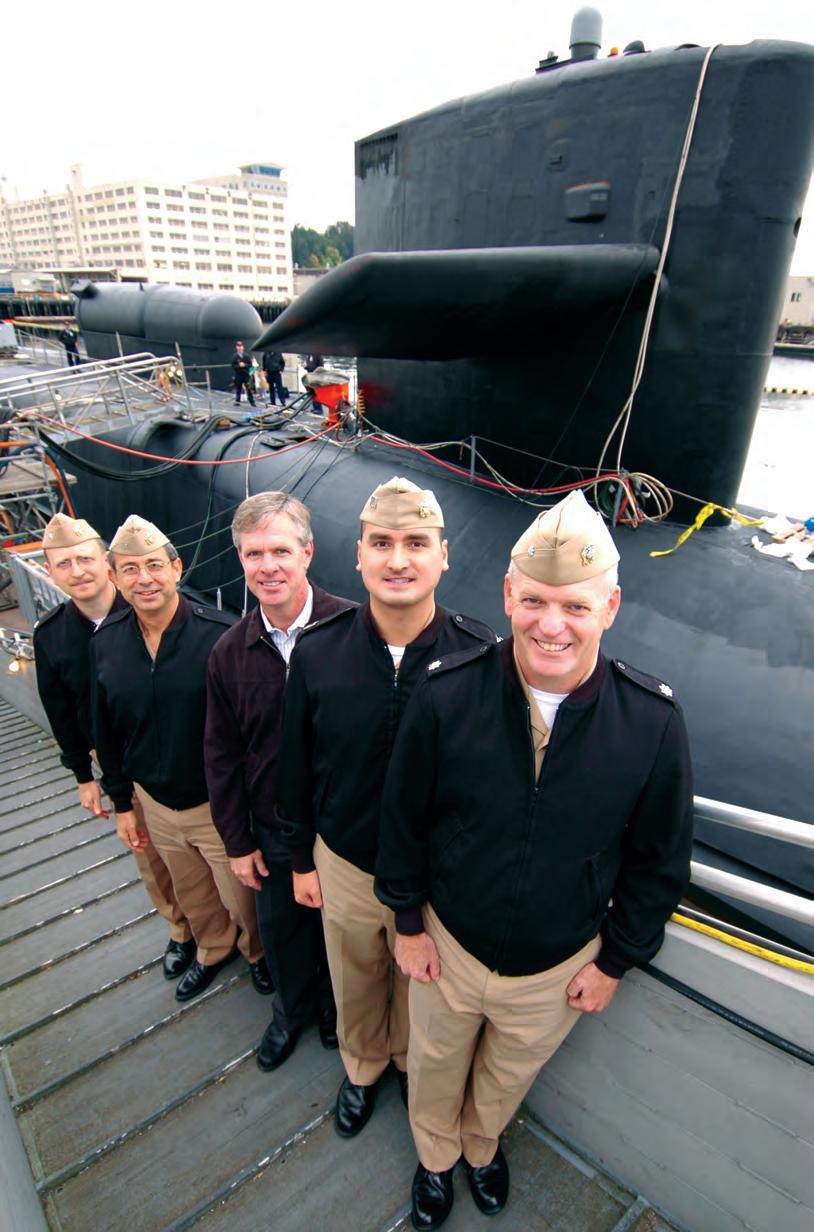
4 minute read
SSGN—Global Presence with Global Support
The successes of the SSGN conversion program have been well chronicled since the 2002 decision to convert the first four Ohio-class submarines from ballistic missile submarines (SSBN) to guided missile submarines (SSGN). Many factions of the government-contractor team have been lauded for their contributions to the overall achievements of the program. However, one group most have likely not heard about, even though they have made
significant contributions to the program for over three years, is the Naval Reserve.
Advertisement
The new SSGN platform and its weapon system have been actively supported by the Naval Reserve Forces since October 2004. At that time, three new SSGN reserve detachments were established to provide support to Commander, Submarine Force (CSF), Commander, Submarine Group NINE (CSG-9) and Commander, Submarine Group TEN (CSG-10).
SSGN
“The Undersea Enterprise reserve component has successfully integrated their critical skills into all parts of the SSGN program,” said Rear Adm. Timothy Giardina, Commander, Submarine Group TRIDENT. “Their assistance in SSGN exercises, operations, planning and maintenance support have positively contributed to the highly successful SSGN program.”
Ten members of the SSGN reserve detachments provided two weeks of sup
Global Presence with Global Support
port to the Joint Command and Control for War on Terror Activities Joint Test and Evaluation (JC2WTA JT&E) team during exercise Tailsman Saber in Australia this past June. Their job was to evaluate the SSGN as a potential platform for the new mission of distributed command and control from a small forward clandestine command post. The exercise was used as a field test for the Tactics, Techniques and Procedures (TTPs) being developed to provide the joint war fighter the tools necessary to execute this mission.
Submarines, especially the SSGN outfitted with the Common Submarine Radio Room and the latest multifunction and high data-rate antennas, make an ideal platform for this new and critical mission. They offer inherent stealth, intelligence, surveillance and reconnaissance (ISR) capabilities, and longer station keeping time than other navy platforms. Each SSGN can deploy with up to 154 TOMAHAWK cruise missiles and are capable of sustaining 66 Special
Operations Force (SOF) personnel and associated equipment to perform a wide variety of missions.
Ohio was delivered back to the operational fleet in December 2005, followed by the USS Florida (SSGN-728) in April 2006, USS Michigan (SSGN-727) in November 2006, and finally USS Georgia (SSGN-729) in December 2007. The SSGN’s deployment cycle leverages the two crew concept and will consist of four separate ten-week operational periods, each one complimented by an overseas voyage repair period and crew exchange. This cycle results in 12 months of forward presence outside of the continental United States followed by a major maintenance period in Kings Bay, Ga. or Bremerton, Wash. The final result will be 2.4 years of annual forward deployed presence by SSGNs.
The following individual reservists on Active Duty Special Work (ADSW) have
Photo by Cmdr. Chuck Cavianni

(Opposite) Members of the SSGN Reserve Office in front of Ohio. From front to back: Cmdr. Bill Lear, Lt. Jonathan King, Van Badzik, Capt. Bill Gieri and Cmdr. Tim Cockrel. (Above) Petty Officer Third Class James Hull of CSG-10 keeps a watchful eye on Ohio.
provided tremendous support to the SSGN project: • Capt. Kevin Doyle is the
Deputy, Joint Test Director for the JC2WTA JT&E office. • Cmdr. Rich Kondo serves as the COMSUBGRU-7 SSGN Development Officer responsible for coordinating and planning exercises and missions for Ohio and Florida while in CTF 54/74 area of responsibility during their first 12 month deployments. • Cmdr. Walt Hockett, on ADSW at Special Operations Command Pacific, is representing the SSGN in their J5 shop and assistingin exercise and mission planning. • Cmdr. John Olsen, as the
Deputy for SSGN Operations for SUBRON-15 in Guam, is assisting with the preparations for the Voyage Repair periods in Guam. • Cmdr. Bill Lear is dual-hatted as the SSGN Operations Officer and Operational Support Officer for COMSUBGRU-TRIDENT and oversees the support of the SSGN detachments, FP detachments and the NSSC detachments on both coasts. • Lt. Jonathan Kingassists Cmdr.
Lear as the SSGN Special Projects assistant at the SSGN Office at COMSUBGRU-9.
The mission of the SSGN Office is to oversee the transition of the SSGN program from a conversion effort to an operational system, serve as the focal point for socialization and feedback on all SSGN issues, and coordinate the follow-on readiness, maintenance, and experimentation for the SSGN program.
The guided missile submarine will be a dynamic, yet covert, asset in the global war on terrorism and requires a highly trained and skilled support network. Reservists have and will continue to provide valuable service to the nation and Navy.
Cmdr. Lear is the SSGN Operations Officer for COMSUBGRU-9.






